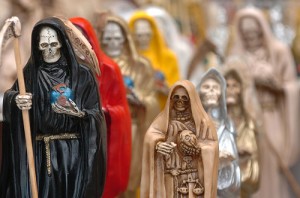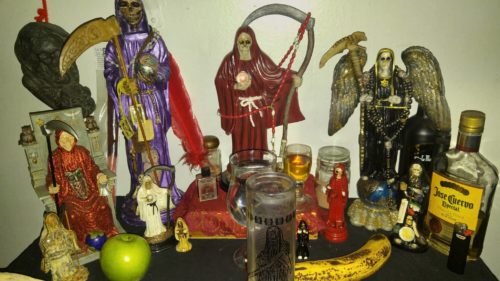![]()
In many ways, practitioners of modern Pagan religions can be seen as renegades. They are often well-educated about, and in many cases raised within, one of the mainstream faiths and have found that faith to be unfulfilling, uninspiring, or otherwise wanting. Rather than giving up, they have sought their own path and found practices that speak to their own needs within their own contexts. Modern Pagans are those who have seen what mainstream society dictates and have rejected that prescription to follow their own path.
However, renegades exist within even the mainstream religions. From practitioners of Santeria to the other blended religions stemming from the European slave trade and quests for colonization, mainstream monotheistic faiths often contain within them their own version of renegade practices. In some cases, such as that of the Virgin of Guadalupe, indigenous visions are incorporated within mainstream doctrine. In other cases, such as that of the growing cult of the iconic La Santa Muerte, “holy death,” in which devout Catholics simultaneously venerate a spirit that is rejected and condemned by the very church these worshipers believe they adhere to.
The result is a renegade saint: a Mexican folk saint who has risen from relative obscurity to international prominence. Robed in colors meaningful to the practitioner and holding power over the one thing that is certain for every living thing on earth, La Santa Muerte is rejected by the Catholic church yet worshiped by millions of Catholics. Her power is so strong that modern Pagans are beginning to feel her call. Perhaps because of her association with the marginalized and misrepresented, this bony and condemned Mexican folk saint is surging in popularity within the Pagan community. Her prodigious power over all living things seems to be growing, reaching out to those outside her culture of origin.

[Time Magazine / EFE / Zumapress.]
Beyond that, Prower points out La Santa Muerte’s openness to all types of people, which also contradicts many traditional Catholic teachings. “Death doesn’t judge,” he says. “She comes for everyone: men, women, young, old, rich, poor, moral, amoral . . . .Because of this, she attracts the devotion on outcast Catholics who are maligned by the Church and machismo Mexican society. That’s why queer people, criminals, and self-empowered women number among her most loyal and numerous devotees.” Pagans who have fled the Catholic faith, or other expressions of Christianity for similar inability to fit into the confines of their birth religion find this folk saint to be a “natural fit.”
Tracey Rollin, author of Santa Muerte: the History, Rituals, and Magic of Our Lady of Holy Death and curator of the Lovely Mother Death Facebook page, agrees with both of Prower’s assessment of the goddess’ growing popularity in Pagan communities. La Santa Muerte, says Rollin, “is accepting of absolutely everyone because she is the power of death incarnate. Everyone will die someday.” Additionally, says Rollin, “her tolerance of witchcraft is well-established in Catholic tradition, which is one of the reasons she is not well-liked by Catholic officials.”
Rollin also notes that there is “spiritual trend” that is shifting “attention and consciousness toward the divine feminine” and a “great interest in the dark feminine in particular.” Rollin believes our world feels troubled right now, so “seeking a spiritual figure who can put an immediate end to our confusion and suffering in order to open the doorway to a brighter and better future is quite natural.” She also notes that La Santa Muerte is ” a very easy spirit to work with” and that the most common work with her involves mostly “a prepared novena candle and reciting a series of prayers,” something familiar to many Witches and magicians,” and she is “famous for responding to requests very quickly.”

[Tracey Rollin.]
La Santa Muerte iconography contains many attributes and much imagery to assist this meditative process. Typical statues depict her in a robe of one (or all) of seven colors, each with its own meaning. She holds a scythe, often a globe or crystal ball, scales, and hourglass; all while being accompanied by an owl.
For Rollin, the most meaningful is her “wide variety of colored robes representing a different aspect of her influence.” A practitioner’s work “involves pairing your intent with the correct aspect,” or color of the saint’s robes. Rollin also finds the globe a particularly meaningful attribute. This is because the globe “represents the great power that death has over everything in the world.” Rollin explains that the power of death is “often considered second only to the wellspring of generative force that created the entire universe” because “death and decay create the need for evolution and growth.” This, she says, makes Santa Muerte “a spiritual power on the highest order.” She explains further that “every act of magical creation causes a change in our own trajectory,” and thus death is present in every act of creation or magic.
Persephone, who connects strongly with the scythe and the crystal ball, agrees. She says that the scythe reminds of “La Santisima Muerte’s reach adn how her reach can go anywhere” since death’s scythe eventually touches all. The crystal ball also reminds of her reach, but in a divinatory sense. It reminds that we are always making choices, and those choices will affect our future. “With choices come consequences,” says Persephone, and this attribute helps her to “understand and accept all the consequences that come with my own actions.”
Prower finds the hourglass to be the most meaningful of her attributes. It represents “how your life is slipping away, grain of sand by grain of sand.” Our lifespans are varied, but “no one really knows how much sand in that hourglass each of us has exactly.” Thus, the hourglass “is a positive reminder that I am going to die.” That reminder motivates him to become “exponentially more industrious, less caught up on trivial drama, and more assertive about what I want.” This is important because, in the end, “how can you devote yourself to death, herself, let alone work with her if you cannot acknowledge death’s power over you.”

[Persephone.]
Persephone cites her own personal experience with the saint. “My beautiful girl has shown herself to me and has truly blessed my life,” she says. Famously, “La Santisima Muerte does not judge us on our spiritual circumstances,” says Persephone. “She does not differentiate a Catholic from a Pagan.”
“Any group of people who claim that only such-and-such a person should have a personal connection with the divine are are people to stay away from,” states Prower emphatically. He connects this view with a “misguided sense of pride and wanting to feel special in changing the world.” He notes that not long ago, veneration of La Santa Muerte was known to only a select few, and those who claim exclusive access feel a loss because “working with her isn’t as special anymore.” Besides, claims Prower, “the Catholic church officially condemns devotion to La Santa Muerte, so what kind of authentic Catholic do these groups think they are?”
Prower adds that “La Santa Muerte is death. She’s not the patron saint of death, she is not a goddess, she is death, itself. How can a primordial energy, as old as life itself, and a defining factor of our biology that affects all beings on this planet be exclusively for only a small group of people? Death comes for everyone,” he reminds us, “literally and figuratively.”
Rollin argues that La Santa Muerte’s roots go back to indigenous Aztec beliefs. They also include grim reaper imagery “imported from Spain” and wise crone goddess of fate worship “all the way from ancient Greece.” Her robes, says Rollin, are “often thought to be adopted from the seven African powers” imported from enslaved Yoruba people forced into the New World. “The wide variety of sources that contribute to La Santa Muerte’s story,” finishes Rollin, “weakens the argument that she should only be worshiped by Catholics.”
For Pagans who are interested in connecting to this powerful entity, Rollin advises a simple beginning. “All she needs is a little altar to call her home,” she says. The altar should include an image of her, “a glass of water, and a small candle.” Offerings and such can be placed at her feet or draped on her statue. Rollin further advises “three keys” to working with death. First, she is “territorial” and does not want to share altar space with another deity. Second, Rollin advises developing a personal relationship with the goddess, who “seeks attention and friendship,” states Rollin, “she really likes people.” This can be done through refreshing the deity’s water, “playing her music, and sipping her treats like candy and tequila” to “reinforce the bond.” The third key is to “embrace death and change as a spiritual power.” In a world that often avoids the subject, the practitioner must come to peace with it.
Prower has two major tips for getting started. First, you must accept the fact that you are going to die. “This will freak you out, and you will feel uncomfortable,” says Prower, “but you cannot develop a relationship with something that you are scared of or refuse to acknowledge.” Second, he advises developing a relationship first with the death deity of your own cultural pantheon. “La Santa Muerte can be a very overwhelming force,” he says, “but by already having a familiarity with a death deity, death herself will be easier to understand.”
Finally, Prower stresses the importance of treating your relationship with Santa Muerte as you would would a relationship with a human friend. If you only come to her when you want nice things, you are not much of a friend. “A real friend is someone who wants to be with you because they enjoy your company and like you for you.” The two of you should share mutual respect and a reciprocal relationship.
“Become a devotee of La Santa Muerte because you like and respect her, not because you want what she can do for you,” concludes Prower. “You’ll see her in the eventually regardless, so be honest now in your intentions in dealing with her.”
* * *
The views and opinions expressed by our diverse panel of columnists and guest writers represent the many diverging perspectives held within the global Pagan, Heathen and polytheist communities, but do not necessarily reflect the views of The Wild Hunt Inc. or its management.
The Wild Hunt is not responsible for links to external content.
To join a conversation on this post:
Visit our The Wild Hunt subreddit! Point your favorite browser to https://www.reddit.com/r/The_Wild_Hunt_News/, then click “JOIN”. Make sure to click the bell, too, to be notified of new articles posted to our subreddit.